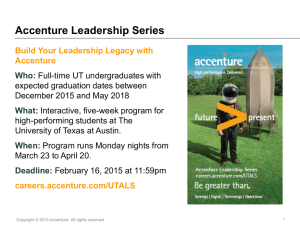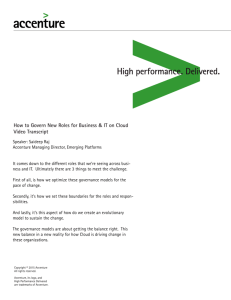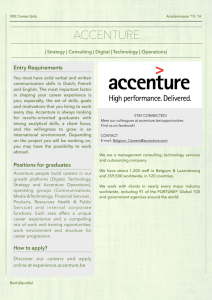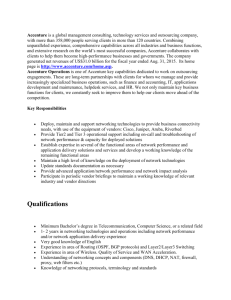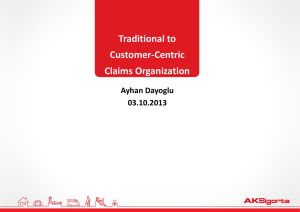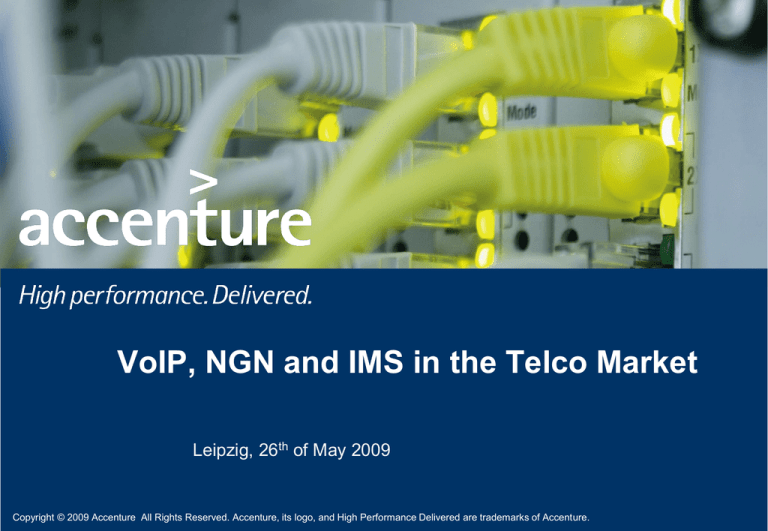
VoIP, NGN and IMS in the Telco Market
Leipzig, 26th of May 2009
Copyright © 2009 Accenture All Rights Reserved. Accenture, its logo, and High Performance Delivered are trademarks of Accenture.
Agenda
• Telco Market Overview
• Voice Over IP
• Next Generation Network
• IP Multimedia Subsystem
• Question & Answers
Copyright © 2009 Accenture All Rights Reserved.
2
Markus Beckmann, Accenture
Areas of Expertise
Markus Beckmann
Senior Manager
Accenture
Maximilianstraße 35
D–80539 München
Personal Background
Married, one child, living in Munich
Education
University Ulm:
Electrical Engineering with focus on Information
Technology, Communications Technology
Diploma Dipl.-Ing. Elektrotechnik in September 2000
Professional Career
With Accenture since November 2000
Munich office (before Frankfurt)
Communications & High Tech Network Practice
Functional Know-How
Network Technology
New Service Development
NW Business Process Outsourcing
Industry Skills
Wireless Communication
Wireline Communication
Cable Service Provider
Accenture Project Experience
German Fix-Mobile Operator
Project Manager for Fix-Mobile Network projects
DSL Business Launch Technical Product Manager
IT Requirement Mgmt & Functional Design Engineer
HanseNet
Alice DSL Business Launch in Germany
Telecom Italia
Pre-IMS Service Control Platform Development
ish / KabelNRW
Service Assurance for VoIP over HFC
Agenda
• Telco Market Overview
• Voice Over IP
• Next Generation Network
• IP Multimedia Subsystem
• Question & Answers
Copyright © 2009 Accenture All Rights Reserved.
4
Sharp increase of IP traffic, which is forecasted to rise in
Western Europe by 52% per annum, largely driven by video
Western Europe IP traffic (Petabytes per month)(1)
8.000
7.000
Key Points
52% CAGR 2007 – 11
Mobile data
6.000
5.000
Consumer internet
4.000
3.000
2.000
Business IP traffic
IP traffic growth will be driven primarily by Consumer
IP Video (non-internet), which is forecast to grow at
97% CAGR 2007-11 i.e. almost doubling each year
Consumer IP Video (non-internet). See note
Mobile data is forecast to grow at 122% CAGR from
2007-11, but still is forecast to represent only 5% of
total IP traffic in 2011
1.000
0
2005
2006
2007
2008
2009
2010
2011
Global Consumer Internet Traffic 2005–2011(1)
(Terabytes per month)
39%
CAGR
A Standard webpage is about ~100kb data whereas
a 10 minute Youtube clip is approx 5MB (3)
12,289,906
6,580,043
P2P
4,801,670
Gaming
3,257,572
2,153,473
1,564,822
Video Comms
VoIP
Internet Video to TV
Internet Video to PC
2005
2006
2007
2008
Approx 8 hours of video are uploaded onto Youtube
every minute (4)
Web, e-mail,
file transfer
8,783,840
Copyright © 2009 Accenture All Rights Reserved.
Today, Youtube accounts for ~20% of all UK internet
traffic (2)
2009
2010
Source: (1) Cisco Systems 2008 “The Exabyte Era”. “Consumer IP Video (noninternet)” refers to IP traffic generated by traditional commercial TV services e.g.
IPTV, Digital Cable. This traffic remains within the footprint of a single service
provider, so it is considered separately from general Internet traffic. (2) UK ISPs,
BBC (3) Vodafone UK 2007 (4) AT&T April 2008
2011
Note: 1 Petabyte = 1000 Terabytes; 1 Terabyte = 1000 Gigabytes
5
Telcos continue to face cost pressure and relatively little progress
has been made on reducing operating costs
Total Revenues, Opex of ~40 European Mobile Operators
Revenue, Opex (€bn)
160
140
120
100
80
Opex 64% of
revenues
Opex 61% of
revenues
Opex 60% of
revenues
60
40
20
0
2002
Total Revenue
Total OPEX
Operators have kept opex at a similar proportion
of revenues, despite lower top line prices i.e. cost
reductions have not occurred
2003
2004
2005
2006
2007
2008E
2009E
2010E
Key points
Revenues are forecast to rise by ~4% CAGR 2002-2010E
Opex is forecast to grow 5% CAGR 2002-10E
Source: Merrill Lynch, 2007; Accenture Analysis 2008
Copyright © 2009 Accenture All Rights Reserved.
6
The Industry Restructure Wave introduces new technologies
such as VoIP, NGN, IMS
Situation
Traffic Volume
Operator Costs – current model
The Perfect Storm
Operator Revenues
# Customers
Data Dominates
Operators are adopting flat rate pricing and much of the
new service revenues are going to other players
This is already an increasingly important issue in fixed
networks and soon to be important in mobile
Operator
revenue &
traffic decoupled
Voice
Dominates
A “Perfect Storm” for operators, as revenue and cost
lines take different trajectories
The increasing popularity of video services is set to
accelerate this e.g. Ofcom estimate £830m (> €1bn)
additional UK investment required by ISPs to deal with
demand caused by video services
Technology improvements are lowering the cost per
MB, but are being deployed slower than the traffic
volumes are rising
Time
Copyright © 2009 Accenture All Rights Reserved.
7
Agenda
• Telco Market Overview
• Voice Over IP
• Next Generation Network
• IP Multimedia Subsystem
• Question & Answers
• Accenture Overview
Copyright © 2009 Accenture All Rights Reserved.
8
Definition – Voice over IP (VoIP)
Voice over Internet Protocol (VoIP)
• VoIP is a general term for a family of transmission technologies for delivery of voice
communications over IP networks such as the Internet or other packet-switched
networks.
• VoIP systems usually interface with the traditional public switched telephone network
(PSTN) to allow for transparent phone communications worldwide.
• VoIP systems employ session control protocols to control the set-up and tear-down of
calls as well as audio codecs which encode speech allowing transmission over an IP
network as digital audio via an audio stream.
VoIP Packets
Copyright © 2009 Accenture All Rights Reserved.
IP Packet-Switched
Network
VoIP Packets
9
VoIP – Usage Cases (1/3)
• VoIP on Application Level in Residential Scenario
– VoIP is used by the end user, e.g. through Softphones (PC), Desk-/Hardphones (Grandstream,
snom,…), or IADs (FritzBox, etc.). Connection to the Internet is via broadband ISP (DSL, Cable).
– The VoIP Service can be offered by the broadband ISP or a Third Party Service Provider. The VoIP
Service Provider usually inter-connects to the traditional telefone network (PSTN/PLMNs).
– In a similar way this can be used by companies for telephone calls. This is usually combined with a
PBX.
vonage.com
Copyright © 2009 Accenture All Rights Reserved.
10
VoIP – Usage Cases (2/3)
• VoIP on Application Level in Business Scenario at Enterprises
– VoIP is used by the end user, e.g. through Softphones (MS Office Communicator) or Deskphones
(Cisco, Siemens,…), and is connected via IP PBX.
– The VoIP traffic is routed on the enterprise's packet switched LAN.
– The IP PBX is connected to the PSTN or an IP WAN (e.g. Internet).
Copyright © 2009 Accenture All Rights Reserved.
11
VoIP – Usage Cases (3/3)
• VoIP is used on the Backbone Transport level
– VoIP is used by the operators for transport on the (long distance) Backbone.
– While end user equipment is legacy (none IP) the VoIP is terminated within the operators Network. The
“last mile” is done on legacy circuit switched access networks.
– Common case for both fix and mobile operators.
Copyright © 2009 Accenture All Rights Reserved.
12
Agenda
• Telco Market Overview
• Voice Over IP
• Next Generation Network
• IP Multimedia Subsystem
• Question & Answers
• Accenture Overview
Copyright © 2009 Accenture All Rights Reserved.
13
Definition – Next Generation Network (NGN)
Fundamental aspects characterize the NGN:
• Packet-based transfer
• Separation of control functions among bearer capabilities, call/session, and
application/ service
• Decoupling of service provision from network, and provision of open interfaces
• Support for a wide range of services, applications and mechanisms based on service
building blocks (including real time/ streaming/ non-real time services and multimedia)
• Broadband capabilities with end-to-end QoS and transparency
• Interworking with legacy networks via open interfaces
• Generalized mobility, i.e. independency from type of access
• Converged services between Fixed/Mobile
• Independence of service-related functions from underlying transport technologies
Copyright © 2009 Accenture All Rights Reserved.
14
Next Generation Network (NGN) Benefits
Benefits to the Telco Industry
One network, multiple access technology where fewer network elements:
– Lower operating cost: space requirement, power consumption, maintenance staff
and service windows are reduced. Training of staff becomes simplified.
– Increase network reliability because of less equipment
– Improve Operations (routing & translations, engineering & capacity planning),
operational efficiency, flexibility and scalability
Benefits to the Users
– Simplified life style with single bill and account - Flexibility to use services without
having to choose fixed line, mobile, BB or ISP suppliers
– Single device in the future with consistent personalization
– Consistent services across all types of access
Copyright © 2009 Accenture All Rights Reserved.
15
VoIP and NGN Key Elements
Softswitches
• Softswitch is a generic term that refers to devices that perform call control and signaling
functions in next-generation networks (NGNs) and, increasingly, IP multimedia subsystem (IMS)
carrier network domains.
• Softswitches are most often deployed in conjunction with media gateways as combined
replacements for TDM-based central office switches.
Media gateways (MGW)
• Media gateways are a class of products generally used to perform basic IP/TDM conversion
under the control of a softswitch or media gateway controller.
• Softswitches typically control media gateways via device protocols such as Media Gateway
Control Protocol (MGCP) or H.248, with the latter predominating in IMS environments.
• Media gateway functionality is related to product scalability, which is characterized by the
number of ports or subscribers supported.
Copyright © 2009 Accenture All Rights Reserved.
16
NGN Network Architecture
Legacy
Copyright © 2009 Accenture All Rights Reserved.
Next Generation
17
NGN Network Architecture – Target Architecture
Copyright © 2009 Accenture All Rights Reserved.
18
NGN Layered Architecture Model
Copyright © 2009 Accenture All Rights Reserved.
19
Agenda
• Telco Market Overview
• Voice Over IP
• Next Generation Network
• IP Multimedia Subsystem
• Question & Answers
• Accenture Overview
Copyright © 2009 Accenture All Rights Reserved.
20
Definition – IP Multimedia Subsystem (IMS)
IP Multimedia Subsystem (IMS):
• IMS is a SIP-based core network architecture in which the transport, control, and services layers are disaggregated.
• The intent is to allow service providers to rapidly and cost-effectively develop real-time multimedia applications and
maintain clear control over services on their networks.
• It is designed to be "access independent" and work in all major broadband environments.
• In the pre-IMS world, services are
specified and supported by a single
logical node, performing specialized
features for the service.
• With the introduction of the IMS
architecture, many functions can be
reused for fast service creation and
delivery. IMS services are hosted by
Application Servers.
• A single Application Server may host
multiple services – for example,
telephony and messaging. Collocation of
multiple services has significant
advantages, especially with regard to
the loading of IMS core network nodes.
Copyright © 2009 Accenture All Rights Reserved.
21
Agenda
• Telco Market Overview
• Voice Over IP
• Next Generation Network
• IP Multimedia Subsystem
• Question & Answers
• Accenture Overview
Copyright © 2009 Accenture All Rights Reserved.
22
Q&A / Discussion
Copyright © 2009 Accenture All Rights Reserved.
23
Agenda
• Telco Market Overview
• Voice Over IP
• Next Generation Network
• IP Multimedia Subsystem
• Question & Answers
• Accenture Overview
Copyright © 2009 Accenture All Rights Reserved.
24
Accenture is a global company …
Our services comprise management consulting, technology and outsourcing.
23,4
Facts
• Founded in 1989
• Approx. 186.000 employees worldwide
• More than 150 offices in 49 countries
• 23.4 billion US$ revenue as of end of
Aug. 2008
19,70
16,65
15,55
13,67
11,44 11,57 11,82
Clients
• Top companies including 91 of the
Fortune Global 100 and two-thirds of the
Fortune Global 500
9,55
9,75
8,22
6,28
4,94
Cooperation
• More than 100 alliances and
partnerships with global market leaders
(e.g. Microsoft, Oracle, SAP, Cisco,
Alcatel-Lucent)
1996 1997 1998 1999 2000 2001 2002 2003 2004 2005 2006 2007 2008
Accenture revenues in US$ since 1996
Copyright © 2009 Accenture All Rights Reserved.
25
… and a strong local player
Geographical Unit ASG
• Austria (A)
• Switzerland (S)
• Germany (G)
Employees
• Over 5.000
Hamburg
Berlin
Düsseldorf
Bonn
Clients
• Leaders in their industries
Frankfurt
Nürnberg
Stuttgart
München
Wien
Zürich
Copyright © 2009 Accenture All Rights Reserved.
26
Accenture’s Network Practice has deep Communications
and High Tech industry focus
Accenture Network Practice provides consulting professionals delivering services and solutions
to the local and worlds leading Telco clients.
Comm. &
High Tech
Financial
Services
Public Service
Products
Resources
Management Consulting
System Integration & Technology Consulting
Outsourcing
Copyright © 2009 Accenture All Rights Reserved.
27
Accenture Network Practice key facts
Accenture Network Practice key facts
The Network Practice within Accenture provides best practices and expertise to the leading
Telecom and Service Providers across the globe.
Accenture Network Practice
NON-EXHAUSTIVE
Part of the Accenture Communications and High Tech
operating group helps wireless, wireline and cable
clients achieve high performance with:
Over 3000 network consultants worldwide
A truly global organization with long history
and strong financial stability
Network Innovation Centers (Sophia Antipolis,
Rome, Dallas)
Near-shore and off-shore delivery and
outsourcing centers.
Sample Clients
Accenture Network Services and Solutions
Are advanced, innovative, proven best practices
and assets that allow introduction of new products
and services and operational costs reduction
Cover business and product development, network
engineering aspects as well as telecom service
design, delivery, integration and operations.
Copyright © 2009 Accenture All Rights Reserved.
28
Campus Team Leipzig – Wer sind wir?
Marko Kunze
- Teamlead Campusteam
Leipzig
- VWL an der TU Chemnitz
- bei Accenture seit 08.2007
Julia Bernhardt
Silke von der Bruck
- Ansprechpartner Prof. Alt
- WiInf an der Uni Leipzig
- bei Accenture seit 12.2006
- Organisation Stammtisch
- WiMat an der Uni Leipzig
- bei Accenture seit 04.2008
Christoph Kurz
Knut Böhmchen
- Ansprechpartner FSR WiWi,
Workshop
- WiInf an der TU Dresden
- bei Accenture seit 11.2007
- Organisation WiWi
- BWL an der Uni Leipzig
- bei Accenture seit 09.2007
Jan Hellich
- Ansprechpartner FSR Inf.
- Inf. an der Uni Leipzig
- bei Accenture seit 05.2008
Accenture Soft Skill Workshop
Campus Team Leipzig Veranstaltungen
Stammtisch
Gastvorlesung
Workshop
Campus Challenge
Veranstaltungen in Leipzig
28.5.2009
Stammtisch
Mai
Juni
26.5.2009
Gastvorlesung
VoIP – Voice over IP
Kontaktadresse für alle Veranstaltungen: marko.kunze@accenture.com
12.6.2009
Softskill Workshop
Juli
8.6.2009
Gastvorlesung
Elektronische Märkte
Accenture and Campus Team contact information
Visit the following links to gain more information about Accenture and Campus Team
activities:
http://www.entdecke-accenture.com
http://careers3.accenture.com/
Careers/ASG/IhrEinstieg/Studenten/Veranstaltungen/
Campus Team contact:
Marko Kunze
marko.kunze@accenture.com
Copyright © 2009 Accenture All Rights Reserved.
32

